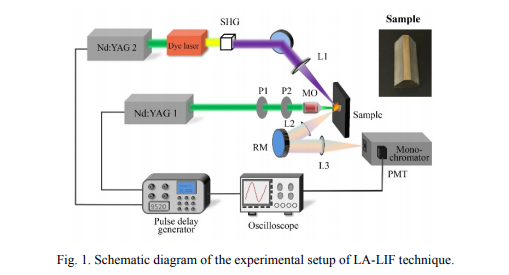Share this
9520 Series Pulse Generator Featured in Application Paper from South China University of Technology!
June 4, 2018
Quantum Composers' 4-Channel 9520 Series Digital Delay Pulse Generator has been featured in the application paper titled: "Surface elemental microanalysis with submicron lateral resolution by the laserablation laser-induced fluorescence technique," from South China University of Technology! The 9524 Pulse Generator is used to control the time delay between an LIF laser pulse and the ablation laser pulse. Read more below:

"Abstract: In order to realize surface elemental microanalysis of solid samples with submicron lateral resolution, laser-ablation (LA) combined with high sensitive laser-induced fluorescence (LIF) detection was investigated. A 532 nm or 266 nm nanosecond laser pulse with low pulse energy was used to realize submicron laser-ablation on the surface of a copper alloy, and LIF technique was used to sensitively detect a minor lead element in the ablated samples. ~344 nm and ~267 nm lateral resolutions could be achieved experimentally under 532 nm and 266 nm laser ablations under the current experimental condition, respectively. This demonstrated the feasibility of using a LA-LIF technique for surface elemental microanalysis of solid samples with submicron spatial resolution. The potentials of continually improving the spatial resolution of this technique to nanoscale were discussed. © 2018 Optical Society of America under the terms of the OSA Open Access Publishing Agreement OCIS codes: (300.2530) Fluorescence, laser-induced; (300.6365) Spectroscopy, laser induced breakdown; (180.2520) Fluorescence microscopy..." "...The LIF laser was generated by a tunable home-made dye laser system followed with a second harmonic generation (SHG) which was described in detail elsewhere [35]. The LIF laser was focused on to the tiny plasma produced by the ablation laser with a plano-convex lens L1 (quartz, f = 150 mm). The wavelength was tuned to the resonant wavelength of lead at 283.31 nm. The propagation direction of the LIF laser beam was parallel to the sample surface. The focal spot was located just in front of the sample surface and the distance from the focal spot to sample surface must be carefully adjusted to avoid sample ablation by the LIF laser. This could be identified by observing if the atomic emission from sample atoms appeared when the ablation laser was blocked. The time delay between the LIF laser pulse Vol. 26, No. 11 | 28 May 2018 | OPTICS EXPRESS 14692 and the ablation laser pulse was controlled by a four-channel pulse delay generator (Quantum Composers, 9520)..."
Read Full Paper Here: https://www.osapublishing.org/DirectPDFAccess/FB01C632-D1B1-3C6D-8E9A5A65B8F178EC_389937/oe-26-11-14689.pdf?da=1&id=389937&seq=0&mobile=no
Learn More About Our 9520 Series Pulse Generator Here: https://www.quantumcomposers.com/pulse-delay-generator-9520
Share this
- photonics (19)
- Lasers (12)
- DPSS Lasers (10)
- pulse delay generator (8)
- pulse generator (8)
- LIDAR (4)
- Lasers and Optics (4)
- Technology (4)
- Laboratory Science (3)
- Nd:YAG Lasers (3)
- PIV (3)
- Science (3)
- Spectroscopy (3)
- custom laser systems (3)
- Aerospace studies (2)
- Commercial Lasers (2)
- LIBS (2)
- Laser Induced Breakdown Spectroscopy (2)
- Laser Research (2)
- Laser Science (2)
- Particle Image Velocimetry (2)
- Pulsed Lasers (2)
- custom lasers (2)
- laser ablation (2)
- laser system (2)
- Biotech (1)
- COVID (1)
- Cancer (1)
- Cancer Diagnostics (1)
- Cancer Research (1)
- Current Generators (1)
- Dentistry (1)
- Emerald Pulse Generator (1)
- Flame Kernel (1)
- High Current Pulse Generator (1)
- Ignition and Combustion (1)
- Ignition flame kernel (1)
- Laser Dentistry (1)
- Laser Manufacturing (1)
- Laser Soldering (1)
- Laser Tooth (1)
- Laser aerospace (1)
- Laser photonics (1)
- MDA (1)
- Mass Spectroscopy (1)
- Micro Soldering (1)
- PIV Laser (1)
- Physics (1)
- Research (1)
- Surface mounted technology (1)
- ablation (1)
- artemis nasa (1)
- blue lasers (1)
- delay generator (1)
- er marketing (1)
- laser attenuator (1)
- laser modules (1)
- laser quality (1)
- laser sales and marketing (1)
- laser synchronizer (1)
- lasers for botanical safety (1)
- lasers for cannabis (1)
- lasers purity (1)
- lasers space (1)
- lunar mission 2021 (1)
- lunar missions (1)
- nasa lasers (1)
- nasa payload (1)
- oem lasers (1)
- photonics sales and marketing (1)
- system synchronizer (1)
- February 2024 (1)
- October 2023 (1)
- December 2022 (1)
- November 2022 (2)
- July 2022 (1)
- May 2022 (1)
- March 2022 (1)
- January 2022 (1)
- December 2021 (2)
- November 2021 (2)
- September 2021 (1)
- August 2021 (1)
- July 2021 (2)
- June 2021 (1)
- May 2021 (2)
- April 2021 (1)
- March 2021 (3)
- February 2021 (1)
- January 2021 (2)
- December 2020 (1)
- November 2020 (2)
- October 2020 (2)
- September 2020 (4)
- August 2020 (3)
- July 2020 (3)
- June 2020 (4)
- May 2020 (2)
- April 2020 (6)
- March 2020 (3)
- February 2020 (3)
- December 2019 (2)
- November 2019 (3)
- October 2019 (2)
- September 2019 (1)
- August 2019 (2)
- May 2019 (1)
- April 2019 (1)
- February 2019 (1)
- October 2018 (2)
- September 2018 (2)
- August 2018 (2)
- July 2018 (1)
- June 2018 (1)
- April 2018 (1)
- March 2018 (1)
- February 2018 (1)
- January 2018 (1)
- December 2017 (2)
- September 2017 (3)
- July 2017 (2)
- June 2017 (2)
- March 2017 (4)
- January 2017 (2)
- November 2016 (2)
- September 2016 (2)
- August 2016 (1)
- May 2016 (1)
- April 2016 (1)
- March 2016 (2)
- December 2015 (2)
- October 2015 (2)
- September 2015 (1)
